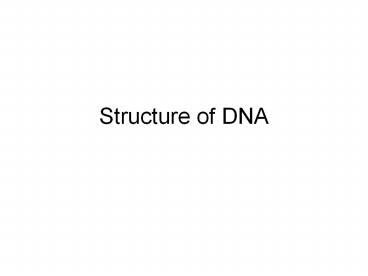Structure of DNA - PowerPoint PPT Presentation
Title:
Structure of DNA
Description:
Structure of DNA Nucleotides Know that DNA contained 4 different types of nucleotides Purines 2 ring bases Adenine Guanine Pyrimidines 1 ring base Thymine ... – PowerPoint PPT presentation
Number of Views:34
Avg rating:3.0/5.0
Title: Structure of DNA
1
Structure of DNA
2
Nucleotides
- Know that DNA contained 4 different types of
nucleotides - Purines 2 ring bases
- Adenine
- Guanine
- Pyrimidines 1 ring base
- Thymine
- Cytosine
3
Chargaffs rules
- Found nucleotide content of DNA not fixed
- Variability between species
- All members of a species have same base
composition - of As of Ts, CG
4
Rosalind Franklin
- X-ray diffraction of DNA
- Showed DNA was helix
- Showed a feature was repeated over and over,
hydrogen bonded bases.
5
Watson and Crick
- Using data from x-ray diffraction, constructed
model of DNA in 1953, - received Nobel Prize in 1962
- Sugar phosphate backbone on outside, base pairs
inside. - Complementary base pairing A with T, C with G
- Pyrimidine always with purine.
6
DNA Replication
- Copying of a DNA molecule
- Old DNA strands used as a template for new one
new strand - Semiconservative replication
- One old strand conserved in each new daughter
molecule.
7
Replication
- Steps
- unwinding (unzipped) DNA helicase, breaking of
weak hydrogen bonds - Complementary base pairing bases are always
available in nucleus - Complementary nucleotides join to form new
strands (DNA polymerase) - DNA polymerase can also be used as a proofreader.
8
Meselson and Stahl 1958
- Replication experiment using cells grown in heavy
and light nitrogen - Results DNA replication is semiconservative
9
Prokaryotes versus Eukaryotes
- Prokaryotic replication
- Replication can occur in 1 or 2 directions
- Very fast, 40 minutes for entire chromosome
- Can happen concurrently
- Eukaryotic
- Begins at numerous origins along chromosome
- Spread bidirectional until they meet
- replication fork V shape when ever DNA is being
replicated - Slower but do cover significant DNA because of
many origins of replication
10
Replication Errors
- Genetic mutation permanent change in sequence
of bases - 1 per 100,000 base pairs at most, after
proofreading, 1 per billion - Mutations can be result of DNA damage
- Environmental factors
- DNA repair enzymes exist and are somewhat
effective. - Remember Mutations are raw material for
evolutionary process!!

